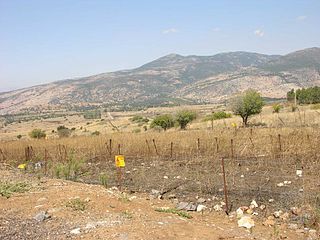This is a list of aviation-related events from 2006.
This is a timeline of events related to the 2006 Lebanon War.

The 2000–2006 Shebaa Farms conflict was a low-level border conflict between Israel and Hezbollah for control of Shebaa Farms, a disputed territory located on the Golan Heights–Lebanon border. Fighting between the two sides primarily consisted of Hezbollah rocket and mortar attacks on Israel and Israeli artillery barrages and airstrikes on Hezbollah in southern Lebanon. Clashes began a few months after the 2000 Israeli withdrawal from Lebanon, which Hezbollah viewed as incomplete due to the presence of the Israel Defense Forces in Shebaa Farms. The conflict culminated in the 2006 Lebanon War; Israel retains control over the territory.
Events in the year 2023 in Lebanon.

Israel and the Lebanese militant group Hezbollah have exchanged fire along the Israel–Lebanon border and in the Israeli-occupied Golan Heights since 8 October 2023. Israel has also carried out airstrikes against Hezbollah throughout Lebanon and in Syria. The conflict is part of the spillover of the Israel–Hamas war and is the largest escalation of the Hezbollah–Israel conflict since the 2006 Lebanon War.
Events of the year 2024 in Israel.
Events in the year 2024 in Lebanon.

Since the beginning of the Israel–Hezbollah conflict on 8 October 2023, the Israeli Defense Forces has killed six journalists and injured at least 15 others in multiple incidents near the Lebanon–Israel border and in Syria. Lebanese residents have also attacked journalists covering the war from Hezbollah controlled areas which injured multiple and one instance resulted in the death of a Lebanese civilian guide.
This timeline of the Israel–Hezbollah conflict covers the period from 2 January 2024, with the Assassination of Saleh al-Arouri, until 31 March 2024, one day prior to the Israeli airstrike on the Iranian consulate in Damascus.
This timeline of the Israel–Hezbollah conflict covers the period from 1 April 2024, when Israel struck the Iranian consulate in Damascus, to 26 July 2024, one day before the Majdal Shams attack.
This timeline of the Israel–Hezbollah conflict covers the period from 27 July 2024, when a Hezbollah rocket struck a soccer field in Majdal Shams in the Golan Heights, killing 12 children, to 16 September 2024, one day before the explosion of Hezbollah pagers and walkie talkies.
On 20 September 2024, Israel launched an air attack that leveled an apartment building in the Dahieh suburb of Beirut, Lebanon. The attack killed at least 45 people, including 16 Hezbollah militants, two of whom were commanders, identified as Ibrahim Aqil and Ahmed Wehbe. They were the second and third Hezbollah commanders assassinated by Israel in two months during the ongoing Israel–Hezbollah conflict, after the killing of Fuad Shukr.
On 23 September 2024, Israel began a series of airstrikes in Lebanon as part of the ongoing Israel–Hezbollah conflict with an operation it code-named Northern Arrows. Since then, Israel's attacks have killed over 800 people, injured more than 5,000, and displaced hundreds of thousands of Lebanese civilians. The attacks are the deadliest in Lebanon since the end of the Lebanese Civil War, and began five days after Israel performed a deadly pager and walkie-talkie attack on devices intended for Hezbollah members, and three days after Israel performed an airstrike on an apartment complex in Beirut which killed Redwan Force commander Ibrahim Aqil as well as 54 others.
This timeline of the Israel–Hezbollah conflict covers the period from 17 September 2024, when Hezbollah pagers exploded throughout Lebanon and Syria to the present. Beginning 23 September, Israel begun its airstrikes in Lebanon, on 27 September, they assassinated Hassan Nasrallah, and on 1 October, they invaded Lebanon.
Citizens and permanent residents of Lebanon have fled the nation or have been internally displaced since the escalation of tensions between Israel and Hezbollah beginning in 2023, and especially during and following the September 2024 Lebanon strikes in southern Lebanon and the Beqaa Valley. As of 25 September 2024, nearly 500,000 people were reported by Lebanese officials to have been displaced due to the strikes.

On 1 October 2024, Israel invaded Southern Lebanon in an escalation of the ongoing Israel–Hezbollah conflict, a spillover of the Israel–Hamas war. It followed a series of major attacks on Hezbollah in September that degraded its capabilities and devastated its leadership, beginning with the explosions of its communication devices. This was followed by a massive Israeli aerial bombing campaign throughout Lebanon, killing over 800 Lebanese people in one week. On 27 September, Israel assassinated Hezbollah leader Hassan Nasrallah in an airstrike.

A battle began in the village of Odaisseh in southern Lebanon on 1 October 2024, amid the 2024 Israeli invasion of Lebanon.
The Israeli Defense Forces conducted airstrikes on the Al-Qard Al-Hasan Association, a Hezbollah-linked financial institution on the night of October 20-21, 2024. During these airstrikes, the Israeli air force targeted a number of Al-Qard Al-Hassan's sites in Lebanon.



